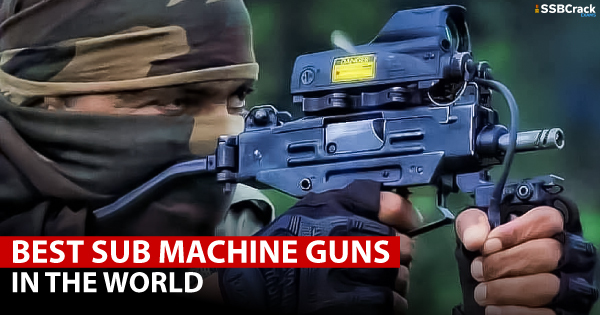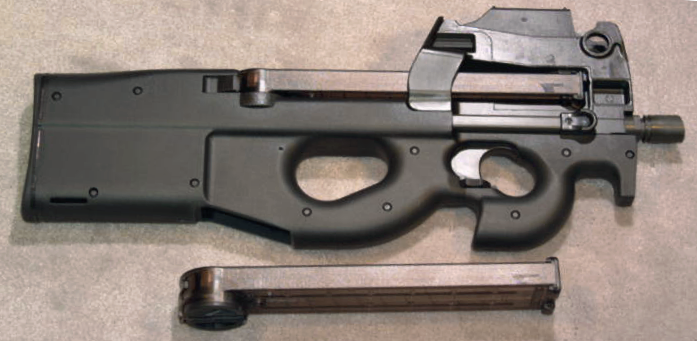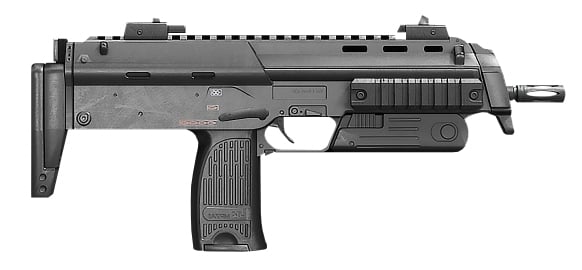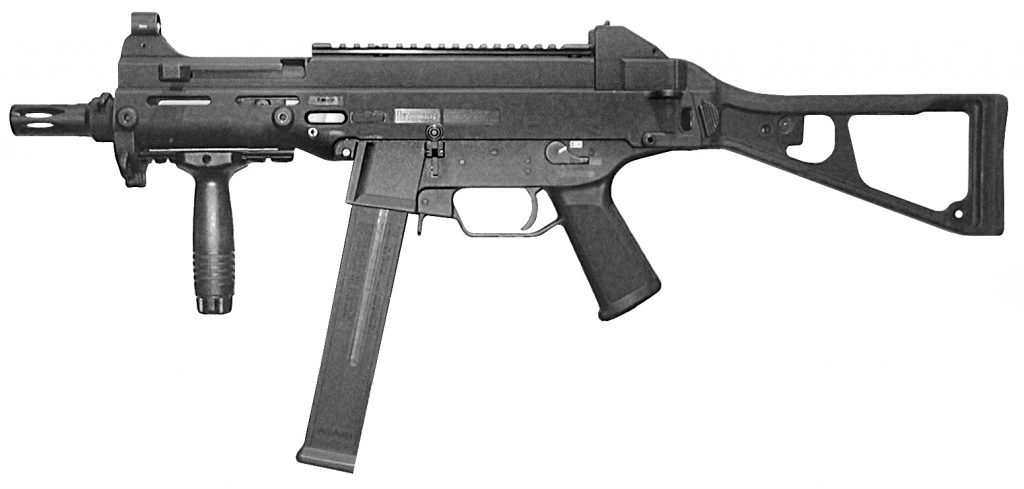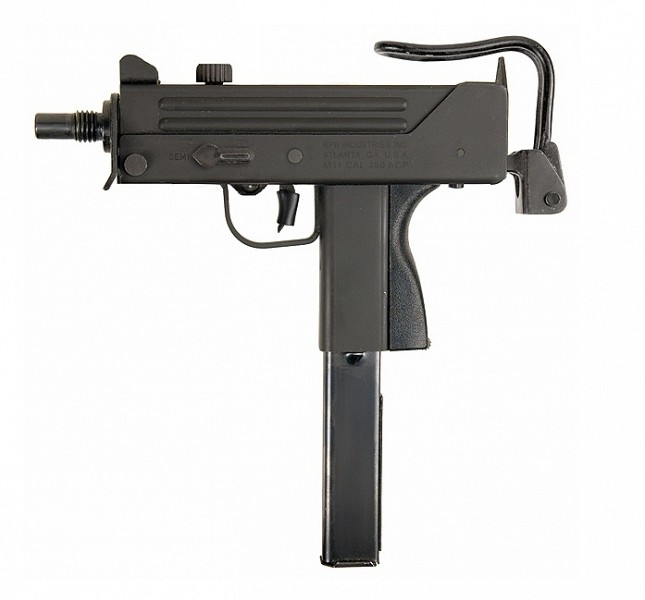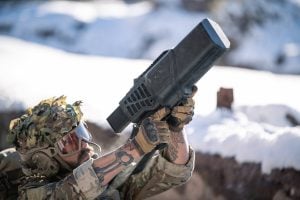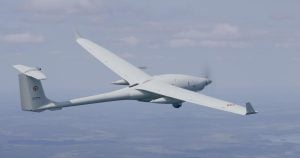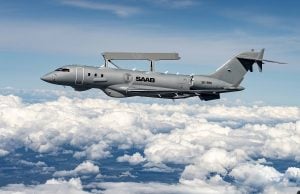Sub-machine guns are the best weapon one can possibly possess for any close quarter for room clearing and counter-terrorist operations as it requires very rapid action in tight spaces. Special forces across the world see these personnel carry submachine guns in regular operations and even are issued as a secondary weapon to specialized troops like combat medics, tank crews, machine gunners, and snipers to help them in tight situations or in case if they lose their primary weapon. These are the best submachine guns all across the world
1. The MP5 submachine gun was developed by Heckler & Koch company in the early 1960s. It proved to be a highly successful design. In 1966 it was adopted by West German police, border guard and special forces. It proved to be an extremely successful design. Despite its age and the advent of new submachine guns and improvements in technology, the MP5 is in service with nearly 90 countries, including Germany. Its production still continues. This weapon is license-produced in Greece, Iran, Mexico, Pakistan, Saudi Arabia, Sudan, Turkey and the United Kingdom. The Heckler & Koch MP5 is one of the most famous firearms of this class. Its only rival in terms of proliferation is the Israeli Uzi submachine gun. The MP5 is a blowback operated, selective fire weapon, chambered for a standard 9×19 mm Parabellum ammunition. However, this submachine gun is unusual because it fires from a closed bolt and has a roller-delay blowback mechanism, similar to that of the Heckler & Koch G3 automatic rifle. It makes this weapon extremely accurate. This submachine gun can be seen as a scaled-down and rechambered version of the G3. The MP5 is a high-quality, reliable and accurate weapon.
2. The Uzi Submachine Gun (SMG) was designed by Uziel Gal, Israel’s army lieutenant, in 1949. This weapon is named in honor of its designer. It was officially adopted in 1951 and was first introduced to Israel’s army special forces in 1954. Two years later it became the standard issue submachine gun with the Israel Defense Force. The weapon was selected by Israel’s army due to its simplicity and ease of production. The Uzi proved to be an extremely successful design. It was so successful, that eventually it had been adopted by more than 90 countries worldwide either for military use or law enforcement forces. Currently, it is still used by around 70 countries from all over the world. Improved versions of this weapon are still produced in Israel. The Uzi was license-produced in Belgium and Rhodesia (now Zimbabwe). Unlicensed copied have been produced in China and Croatia. Also, there are numerous clones of this successful weapon. The Uzi is simple in design and technology. It is made primarily from stamped sheet metal. Also, it has relatively few moving parts. It is an open bolt, blowback operated submachine gun. It is chambered for a Standard 9×19 mm Parabellum round. This submachine gun is fitted with a manual safety switch, which is also a fire mode selector. It has semi-auto and full-auto modes. There is an additional automatic grip safety button. The weapon will not fire until both safeties are disengaged. These features reduce the chance of accidental firing.
3. The P90 is not a typical submachine gun. It was developed in Belgium by Fabrique Nationale (FN) in the late 1980s. It was chambered for entirely new ammunition and intended as a personal defense weapon for non-front line troops, vehicle drivers, tank and artillery crews. The FN P90 was introduced in the early 1990s. At the time of its introduction, it was considered a new generation weapon. It was the first personal defense weapon and in terms of dimensions, weight and firepower took an intermediate position between submachine guns and assault rifles. The P90 was so successful, that it is currently in service with nearly 50 countries, where it is used by military and law enforcement forces. The FN P90 is a clean sheet design with a number of unusual features. It is a blowback operated, selective fire weapon with a bullpup layout, which fires from a closed bolt. It is chambered for newly-developed 5.7×28 mm ammunition with sharp nose bullets. This round has enhanced penetration comparing with the standard 9×19 mm Parabellum round and is effective against body armor at ranges of 100 m and beyond. It resembles a scaled-down standard NATO 5.56×45 mm rifle round. Eventually, the P90 has significantly improved range and penetration comparing with standard submachine guns. The FN P90 has minimal size and weight. Its furniture is made of impact-resistant polymer. This submachine gun is easy to use and maintain. It has low recoil and can be easily controlled with one hand.
4. The MP7 submachine gun was developed by the famous Heckler & Koch company of Germany. Originally this weapon was known as the HK PDW or Personal Defense Weapon. It was designed as a competitor for a successful Belgian Belgian FN P90. The German weapon uses new intermediate ammunition. It is intended for non-front line troops, vehicle drivers, tank and artillery crews, as well as special forces units, VIP protection teams and hostage rescue units. The MP7 was first revealed in 2000. Its production commenced in 2001. Currently, it is in service with Germany and more than 20 other countries, including South Korea and the United Kingdom. The Heckler & Koch MP7 is a gas operated, selective fire weapon. Its internal design resembles that of the HK G36 assault rifle but scaled down. Otherwise, it has a layout of a typical submachine gun. This SMG is chambered for a new Heckler & Koch 4.6×30 mm high-velocity ammunition.
This ammunition is also used by the HK UCP pistol. The 4.6×30 mm round fits the gap between pistol rounds and rifle rounds. It is superior in terms of range and penetration to the standard 9×19 mm Parabellum round, used by most submachine guns. The MP7 has the dimensions and weight of a typical submachine gun, but at close ranges delivers the firepower of an assault rifle. It is claimed that the MP7 penetrates a standard CRISAT body armor at a range of 200 m. Many operators use this weapon for offensive, rather than defensive roles. The MP7 is often used for offensive roles by assault teams or special operations forces for close quarter combat. Sometimes it is even used as a primary weapon.
5. The Heckler & Koch UMP submachine gun was designed as a successor to the famous MP5 in the mid-1990s. The main goal was to design a lightweight and powerful SMG, which would be cheaper than the MP5. This weapon was aimed mainly at US law enforcement market. Its production commenced in 1999 and it is still produced. However, this weapon could not surpass its predecessor in terms of popularity and proliferation. The UMP is in service with more than 20 countries. The HK UMP is a blowback-operated, selective fire weapon, fired from the closed bolt. Its first versions, the UMP-45 and UMP-40 were chambered for .45 ACP and .40 SW ammunition respectively. Later a 9×19 mm version became available (UMP-9). All versions have a similar design, apart from the different chambering. The UMP can fire in semi-auto, full-auto, 2- or 3-round burst modes. Its fire mode selector also acts as a safety lock. This fire mode selector is fully ambidextrous. Cocking handle is located at the front of the receiver. The HK UMP is available with 25- and 30-round capacity magazines. The UMP-45 is typically fed from 25-round magazines. Other versions are fed from the 30-round ones. It is worth mentioning that the .45 ACP and .40 SW versions use straight magazines, while the 9 mm version comes with curved magazines. This SMG comes with adjustable iron sights and also has a scope rail on top of the receiver, which is used to mount various sights. This submachine gun has an effective range of about 100 meters.
6. The Beretta PM12 submachine gun was developed during the 1950s. It was first revealed in 1959. Letters PM in the designation stand for “Pistola Mitragliatice”, or machine pistol. In 1961 this weapon was adopted by the Italian Army, special forces and law enforcement forces. By modern standards this weapon is outdated. Though it is still used in Italy and some other countries. It is likely that it will remain in service for many years to come. This submachine gun was license-produced in Belgium, Brazil, and Indonesia. The PM12 is a compact weapon. Beretta designed this submachine gun, that could be used by foot soldiers, as well as vehicle crews. The Beretta PM12 has a stamped steel construction and a tubular receiver. Both ends of the receiver are blocked by screw-on caps. This weapon has a minimum of moving parts. However, despite its simplistic appearance, this submachine gun was actually expensive to produce. The PM12 is a blowback-operated weapon, which fires from an open bolt. This submachine gun is chambered for standard NATO 9×19 mm Parabellum ammunition. The Beretta PM12 proved to be a robust, comfortable to use and accurate weapon. The weapon is very stable when being fired. Though by modern standards this submachine gun is too heavy. The original PM12 had a safety button, located over the pistol grip. A fire mode is changed between “semi-auto” and “full-auto” by pressing another button located above the pistol grip. Such arrangement was quite unusual. There is also an automatic grip safety, which is disengaged only when the shooter grips the weapon. Overall this submachine gun is very safe to use. Both manual and automatic safeties prevent accidental discharges. This weapon is fed from 20-, 32-, or 40-round capacity magazines.
7. The MAC-10 submachine gun was designed by Gordon B. Ingram, an American arms designer. He began to work on this compact weapon in the mid-1960s. This submachine gun was mainly aimed at special operations and law enforcement forces, as well as VIP security teams. By 1965 several prototypes were made. This submachine gun was evaluated by the US Army, however it was not adopted. Production commenced in 1970 by the Military Armament Corporation (MAC). In 1976 the MAC went bust and production rights for this weapon were transferred to RPB Industries Inc. Later this submachine gun was also manufactured by some other companies. Ingram’s submachine guns were exported to Chile, Yugoslavia and some other Asian and South American countries. Copies of this weapon were manufactured in Japan, South Africa and Taiwan. Today the MAC-10 is no longer a premier submachine gun. However, it is still used by around 15 countries. These submachine guns have been designed for close encounters and concealed carrying. It is a blowback-operated, selective fire weapon, that fires from an open bolt. It has some features of the Israeli Uzi. There are two baseline MAC-10 (or M10) models, chambered for 11.43 (.45 ACP) and 9×19 mm Parabellum rounds. This weapon is simple in design and technology. Its receiver is made of sheet steel and consists of only two parts. These are held together by a steel pin. Generally, the MAC-10 is a reliable weapon.
8. The Scorpion EVO 3 is a submachine gun, developed by Ceska Zbrojovka company. This weapon is referred to as Skorpion in the Czech Republic. However, for the rest of the world, it is marketed as Scorpion. The “EVO 3” denotes that it is a third generation weapon. Though in terms of design this weapon is unrelated to the original Sa vz.61 Skorpion. It is actually based on a Luago prototype submachine gun, developed in Slovakia around 2002. Design on the Luago was sold to Ceska Zbrojovka company. The Scorpion EVO 3 was first publicly revealed in 2009. This weapon is mainly aimed at law enforcement forces. It has been adopted by the armed forces and police of the Czech Republic. The Scorpion EVO 3 has been exported to Argentina, Bolivia, Egypt, Indonesia, Malaysia, Malta, Panama, Paraguay, Philippines, Serbia, Thailand, Vietnam, and possibly some other countries. The Scorpion EVO 3 is a lightweight and compact submachine gun. It is suitable for concealed carrying and for use inside buildings, vehicles and other narrow spaces. It is a blowback operated weapon, which fires from a closed bolt. This weapon is chambered for standard 9×19 mm Parabellum ammunition. There is also a version chambered for .40S&W ammunition, which is very popular as a police round in the United States. Receivers and many other components of this weapon are made of polymer materials in order to save weight.
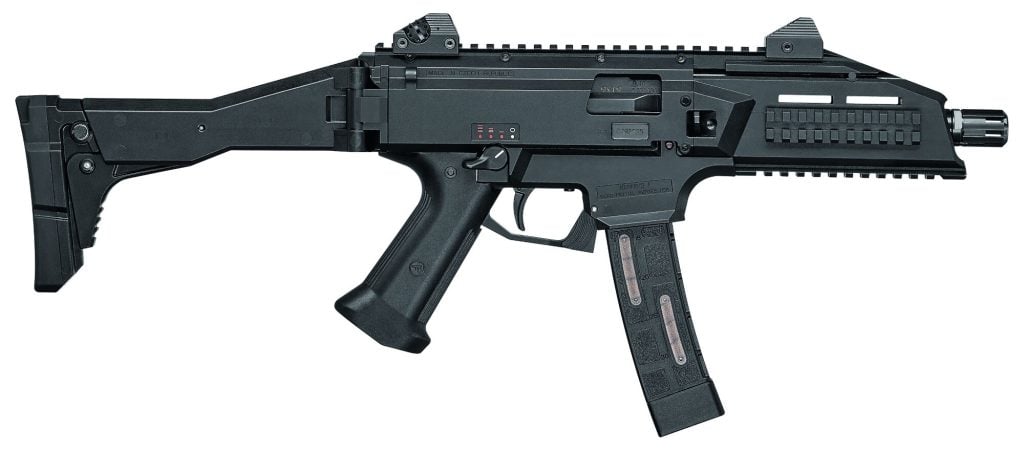
9. The Brugger & Thomet MP9 submachine gun is a further development of the Austrian Steyr TMP. In 2001 Steyr stopped production of the TMP submachine gun because of the lack of sales and sold production licenses to the Swiss arms manufacturer. Swiss arms designers made over 19 engineering changes to the Austrian weapon. Production of the MP9 commenced in 2004. Currently, it is in service with the Swiss army and law enforcement forces. This submachine gun has been exported to Bulgaria, India, Indonesia, Malaysia, the Netherlands, Portugal, Russia, Thailand, and possibly, some other countries. The Brugger & Thomet MP9 is a blowback operated, selective fire weapon, which fires from a closed bolt. This submachine gun is chambered for standard 9×19 mm Parabellum ammunition. The Brugger & Thomet submachine gun is smaller than the German Heckler & Koch MP5 or similar designs, however, this SMG offers more controllable fire than automatic pistols. It falls in the same niche as the Mini Uzi and MAC-10. Its compact size and lightweight make this weapon suitable for law enforcement teams and special operations units. However, it loses to bigger SMGs in terms of range and accuracy. The B&T MP9 comes with an integral front grip and thus is more controllable during fully automatic firing. This SMG can be fired single-handedly. The housing of this weapon is made from lightweight polymer materials. The MP9 has new trigger safety, as well as an ambidextrous safety/fire mode selector button, located behind the trigger. An ambidextrous cocking handle is located at the rear of the receiver. It resembles that of the M16 assault rifle. It does not reciprocate when the weapon is fired.
10. The SAF is a submachine gun developed in Chile by Fabricas y Maestranzas del Ejercito (FAMAE). The FAMAE is a small state-owned arms factory. Production of this weapon commenced in 1993. It is in service with Chilean armed forces and law enforcement forces. Also, it has been exported to some countries, including Portugal. The FAMAE SAF is modeled after a popular and highly successful German Heckler & Koch MP5 submachine gun. It is based on the FAMAE SG 540 assault rifle, which is a license-produced version of the Swiss SIG SG 540. This assault rifle was produced by FAMAE in the 1980s. The SAF can be seen as a scaled-down and rechambered version of the SG 540 assault rifle. It is a blowback-operated weapon, which is fired from a closed bolt. Though rotating bolt has been redesigned replaced by a simple blowback bolt. Upper and lower receivers are connected by two steel pins in the same manner as on the M16 assault rifle. This submachine gun is chambered for standard 9×19 mm Parabellum ammunition. There is also a version chambered for .40S&W ammunition. The overall design of this weapon proved to be successful.
Also Read:
